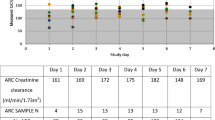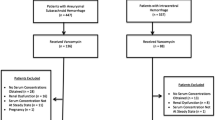Abstract
Background and Objective
Patients with severe trauma exhibit augmented renal clearance, which can alter the dosing requirement of renally eliminated drugs. This study aimed to develop a population pharmacokinetic model for levetiracetam in patients with severe traumatic brain injury and aneurysmal subarachnoid hemorrhage, and use it to describe optimal dosing regimens.
Methods
This was a prospective open-label observational study. Critically ill adult patients with severe traumatic brain injury or aneurysmal subarachnoid hemorrhage without renal dysfunction and receiving levetiracetam were eligible. Serial levetiracetam plasma concentrations were analyzed to develop a population pharmacokinetic model and perform dosing simulations.
Results
A two-compartment model best described the concentration–time data from 30 patients. The mean ± standard deviation parameter estimates were bioavailability (F) of 0.8 ± 0.2, absorption rate constant of 2.4 ± 2 h−1, clearance 2.5 ± 1.1 L/h, central volume of distribution 8.9 ± 3.0 L/h, and transfer rate constraints of 1.8 ± 1.1 h−1 from central to peripheral compartments and 0.7 ± 0.3 h−1 from peripheral to central compartments. For the simulated intermittent dosing regimens, on average, the median trough concentration reduced by 50% for every 40-mL/min/1.73 m2 increase in urinary creatinine clearance. Simulated doses of at least 6 g/day were required for some levels of augmented renal clearance.
Conclusions
Patients with severe traumatic brain injury and aneurysmal subarachnoid hemorrhage with augmented renal clearance are at risk of not achieving target levetiracetam plasma concentrations. We suggest dose titration guided by measured creatinine clearance, and/or, therapeutic drug monitoring if available, to minimize the risk of seizures.



Similar content being viewed by others
References
Privitera M. Efficacy of levetiracetam: a review of three pivotal clinical trials. Epilepsia. 2001;42(Suppl. 4):31–5.
Lim DA, Tarapore P, Chang E, Burt M, Chakalian L, Barbaro N, et al. Safety and feasibility of switching from phenytoin to levetiracetam monotherapy for glioma-related seizure control following craniotomy: a randomized phase II pilot study. J Neurooncol. 2009;93:349–54.
Alsaadi TM, Shatzel A, Marquez AV, Jorgensen J, Farias S. Clinical experience of levetiracetam monotherapy for adults with epilepsy: 1-year follow-up study. Seizure. 2005;14:139–42.
Steinhoff BJ, Staack AM. Levetiracetam and brivaracetam: a review of evidence from clinical trials and clinical experience. Ther Adv Neurol Disord. 2019;12:1756286419873518.
Farrokh S, Tahsili-Fahadan P, Ritzl EK, Lewin JJ 3rd, Mirski MA. Antiepileptic drugs in critically ill patients. Crit Care. 2018;22:153.
Nau KM, Divertie GD, Valentino AK, Freeman WD. Safety and efficacy of levetiracetam for critically ill patients with seizures. Neurocrit Care. 2009;11:34–7.
Spencer DD, Jacobi J, Juenke JM, Fleck JD, Kays MB. Steady-state pharmacokinetics of intravenous levetiracetam in neurocritical care patients. Pharmacotherapy. 2011;31:934–41.
Strolin Benedetti M, Whomsley R, Nicolas JM, Young C, Baltes E. Pharmacokinetics and metabolism of 14C-levetiracetam, a new antiepileptic agent, in healthy volunteers. Eur J Clin Pharmacol. 2003;59:621–30.
Uges JW, van Huizen MD, Engelsman J, Wilms EB, Touw DJ, Peeters E, et al. Safety and pharmacokinetics of intravenous levetiracetam infusion as add-on in status epilepticus. Epilepsia. 2009;50:415–21.
Rhee SJ, Shin JW, Lee S, Moon J, Kim TJ, Jung KY, et al. Population pharmacokinetics and dose–response relationship of levetiracetam in adult patients with epilepsy. Epilepsy Res. 2017;132:8–14.
Udy AA, Roberts JA, Shorr AF, Boots RJ, Lipman J. Augmented renal clearance in septic and traumatized patients with normal plasma creatinine concentrations: identifying at-risk patients. Crit Care. 2013;17:R35.
Sime FB, Udy AA, Roberts JA. Augmented renal clearance in critically ill patients: etiology, definition and implications for beta-lactam dose optimization. Curr Opin Pharmacol. 2015;24:1–6.
Udy A, Boots R, Senthuran S, Stuart J, Deans R, Lassig-Smith M, et al. Augmented creatinine clearance in traumatic brain injury. Anesth Analg. 2010;111:1505–10.
Claus BO, Hoste EA, Colpaert K, Robays H, Decruyenaere J, De Waele JJ. Augmented renal clearance is a common finding with worse clinical outcome in critically ill patients receiving antimicrobial therapy. J Crit Care. 2013;28:695–700.
Cook AM, Arora S, Davis J, Pittman T. Augmented renal clearance of vancomycin and levetiracetam in a traumatic brain injury patient. Neurocrit Care. 2013;19:210–4.
Patsalos PN, Berry DJ, Bourgeois BF, Cloyd JC, Glauser TA, Johannessen SI, et al. Antiepileptic drugs: best practice guidelines for therapeutic drug monitoring: a position paper by the subcommission on therapeutic drug monitoring, ILAE commission on therapeutic strategies. Epilepsia. 2008;49:1239–76.
Mushtaq R, Wannamaker B. Levetiracetam blood levels have utility in clinical management of epilepsy. In: International league against epilepsy. Annual meeting of the American Epilepsy Society, December 6-11; Seattle (WA); 2002: p. 351.
Lindholm D. Levetiracetam levels correlating with successful treatment of epilepsy, headaches, cognitive effects, and adverse reactions in pediatric age group. In: Annual Meeting of the American Epilepsy Society. Seattle, Washington: International League Against Epilepsy. Epilepsia. 2002;43(Suppl. 7):1–351.
Johannessen SI, Battino D, Berry DJ, Bialer M, Kramer G, Tomson T, et al. Therapeutic drug monitoring of the newer antiepileptic drugs. Ther Drug Monit. 2003;25:347–63.
Leppik IE, Rarick JO, Walczak TS, Tran TA, White JR, Gumnit RJ. Effective leviteracetam doses and serum concentrations: age effects. In: Annual Meeting of the American Epilepsy Society. Seattle, Washington: International League Against Epilepsy, F.04 Epilepsia. 2002;43(Suppl. 7):1–351.
Loscher W, Brandt C. Prevention or modification of epileptogenesis after brain insults: experimental approaches and translational research. Pharmacol Rev. 2010;62:668–700.
Toublanc N, Lacroix BD, Yamamoto J. Development of an integrated population pharmacokinetic model for oral levetiracetam in populations of various ages and ethnicities. Drug Metab Pharmacokinet. 2014;29:61–8.
Pigeolet E, Jacqmin P, Sargentini-Maier ML, Stockis A. Population pharmacokinetics of levetiracetam in Japanese and Western adults. Clin Pharmacokinet. 2007;46:503–12.
Ramael S, De Smedt F, Toublanc N, Otoul C, Boulanger P, Riethuisen JM, et al. Single-dose bioavailability of levetiracetam intravenous infusion relative to oral tablets and multiple-dose pharmacokinetics and tolerability of levetiracetam intravenous infusion compared with placebo in healthy subjects. Clin Ther. 2006;28:734–44.
Ramael S, Daoust A, Otoul C, Toublanc N, Troenaru M, Lu ZS, et al. Levetiracetam intravenous infusion: a randomized, placebo-controlled safety and pharmacokinetic study. Epilepsia. 2006;47:1128–35.
Toublanc N, Du X, Liu Y, Chen Q, Singh P, Chan R, et al. Pharmacokinetics, safety and bioequivalence of levetiracetam intravenous infusion and oral tablets in healthy Chinese subjects. Clin Drug Investig. 2015;35:495–503.
Keur MB, Beishuizen A, van Bodegraven AA. Diagnosing malabsorption in the intensive care unit. F1000 Med Rep. 2010;2:7.
Mink S, Muroi C, Seule M, Bjeljac M, Keller E. Levetiracetam compared to valproic acid: plasma concentration levels, adverse effects and interactions in aneurysmal subarachnoid hemorrhage. Clin Neurol Neurosurg. 2011;113:644–8.
Acknowledgements
Jason A. Roberts acknowledges funding from the Australian National Health and Medical Research Council for a Centre of Research Excellence (APP1099452) and a Practitioner Fellowship (APP1117065).
Author information
Authors and Affiliations
Corresponding authors
Ethics declarations
Funding
This work was supported by Grants from the Royal Brisbane and Women’s Hospital Foundation and the Intensive Care Foundation, Australia.
Conflict of interest
Fekade Bruck Sime, Jason A. Roberts, Rosalind L. Jeffree, Saurabh Pandey, Santosh Adiraju, Amelia Livermore, Jenie Butler, Suzanne L. Parker, Steven C. Wallis, Jeffrey Lipman, and Menino Osbert Cotta have no conflicts of interest that are directly relevant to the content of this article.
Consent to participate
All study participants provided written informed consent.
Consent for publication
All authors apporved and provided consent for publication.
Ethics approval
The University of Queensland and Royal Brisbane and Women’s Hospital Human Research Ethics Committees granted ethical clearance (Reference 2016000790 and HREC/16/QRBW/154, respectively).
Availability of data and material
Data are available provided that ethical clearance is obtained for additional access/use.
Code availability
The software used is freely available from LAPKB, University of Southern California, no custom code is applicable.
Authors’ contribution
FBS-data analysis, Pop PK modeling, writing manuscript; JAR-conception, review of study design, critical review of manuscript, RLJ-conception, review of study design, critical review of manuscript; SP-assay method development, sample analysis, review of manuscript; SA-assay method development, sample analysis, review of manuscript, AL-data collections, review of manuscript; JB-data collection, review of manuscript, SLP-assay method development, sample analysis, review of manuscript, SCW-assay method development, sample analysis, review of manuscript, JL-conception, critical review of manuscript, MOC-conception, study design, grant acquisition, supervision of data collections, critical review of manuscript.
Rights and permissions
About this article
Cite this article
Sime, F.B., Roberts, J.A., Jeffree, R.L. et al. Population Pharmacokinetics of Levetiracetam in Patients with Traumatic Brain Injury and Subarachnoid Hemorrhage Exhibiting Augmented Renal Clearance. Clin Pharmacokinet 60, 655–664 (2021). https://doi.org/10.1007/s40262-020-00979-8
Accepted:
Published:
Issue Date:
DOI: https://doi.org/10.1007/s40262-020-00979-8




